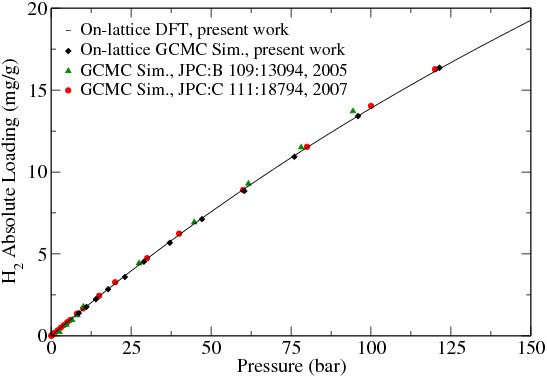

44674-AC10
Three-Dimensional Reconstruction of Mesoporous Materials from Gas Adsorption and Structure Factor Data
We work on theoretical and computational methods for the prediction of gas adsorption in porous materials. In previous work, we have used both atomistic simulations and coarse-grained lattice-gas models to obtain gas adsorption isotherms in mesoporous materials (with pore sizes of 2-50 nm). Of these, atomistic simulations are more realistic, though extremely expensive, while lattice-gas calculations are rapid, but less accurate; nonetheless, nearly quantitative results can be obtained in materials with large pores.
For the prediction of adsorption in microporous materials such as zeolites, carbon nanomaterials and coordination polymers such as metal-organic frameworks (MOFs), coarse-grained models are inappropriate; the pore sizes are comparable with the size of the adsorbing molecules, and so must be described at much higher quality. Adsorption in such materials is of significant industrial importance, impacting catalysis and separations. Adsorption in microporous materials is also frequently suggested as the basis for storage of hydrogen and methane gases. We have derived a density functional theory of high-resolution lattice fluids and shown that with lattice discretizations as coarse as d/6 = 0.5 Å (d is the molecular diameter), we can obtain quantitative agreement with off-lattice (atomistic) simulations at relatively modest computational cost. This is the first computationally tractable adsorption model that can be applied in realistic models of microporous materials; all previous adsorption modeling using fluid density functional theory have relied on idealized models and high symmetry to reduce the dimensionality and computational cost of the problem. Our approach is based on an on-lattice re-derivation of Tarazona's (1985) original continuum weighted-density (off-lattice) theory, with appropriate parameterization of hard-sphere terms against simulation results for the uniform hard-sphere lattice fluid. This approach lets us use lattice spacings intermediate between the ~0.1 Å used in most continuum fluid DFT and > 3.5 Å used in "coarse-grained" lattice gases, achieving the accuracy of the former at the low computational cost of the latter. Furthermore, since the lattice approximation is made at the level of the underlying model rather than the integration, the usual integrals are replaced by exact summations and numerical difficulties are greatly reduced. As an example application, the Figure (below) shows a comparison of the theory and several simulations for hydrogen adsorption in the MOF-5 material. 
Adsorption in MOF-5 at 298 K. The black line are the DFT predictions. Black diamonds are results from simulations of the on-lattice model, red circles are literature results for off-lattice simulations with the same potential as used here, and green triangles are literature results for off-lattice simulations using a slightly different potential.